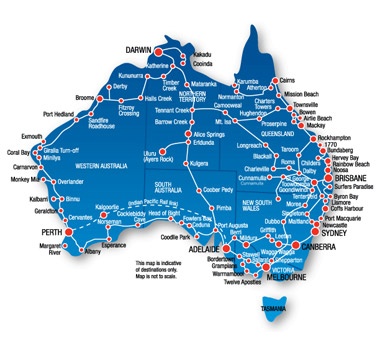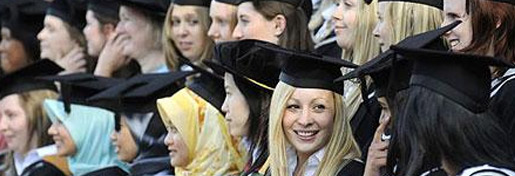Study in Australia
Five Quick Points about the Australia
Location and Geography


Australia is an island continent of approximately 7.7 million square kilometers, making it the sixth-largest country in the world. Located between the Indian Ocean and the South Pacific Ocean, it is the oldest, lowest (apart from Antarctica), and driest continent
Because of its unique and varied geography, it is an archaeologist’s delight, with landforms dating back millions of years. Australia is mostly flat, but has some notable mountains and long beaches. Canberra is the capital.
Climate
The climate ranges from tropical in the north to temperate in the south. The largest part of Australia is desert or semi-arid. Overall, Australian cities enjoy a mild climate, with maximum temperatures falling in a fairly narrow range (e.g., in the summer in Sydney, the temperature might range from 16° to 26° Celsius). But the continent is large, and international students should be informed about the individual climates of the regions they are interested in. They should also be aware that the Australian sun can be very strong.
History and Population
Aboriginal peoples settled Australia about 60,000 years ago – there were many distinct languages and dialects, and customs varied greatly from region to region. British settlement began in 1788, and for a time Australia was actually used as a penal colony (the first fleet of convicts arrived January 26, 1788, and the country still marks this occasion on that date with a holiday called Australia Day). The penal era ended in 1868. The settlement developed into six self-governing colonies which federated in 1901 to form Australia, a nation founded on ideals of egalitarianism, human rights, harmony, and democracy. Since the 1950s, large numbers of displaced people have immigrated to Australia, and this has had a profound effect on its society and culture.
The population is more than 21 million, and is highly urbanized. Just over 60% of Australians live in the main cities and almost 80% within 100 kimometres of a major city. Nearly one in four Australians were born overseas. Australia is predominantly a Christian country, with English the official language. It is a member of the British Commonwealth.
Society and Culture
Australian society is safe, friendly, sophisticated, and harmonious. Many ethnic groups are represented in Australia, making it one of the most culturally diverse countries in the world. The country’s proximity to the Asia-Pacific region also influences its culture, economy, and lifestyle. The government of Australia describes the values underpinning the Australian way of life as:
There are many ways to take part in Australian culture, from enjoying the vibrant dining out scene to barbequing on a beach, and from taking in a world-class theatre event to throwing on a backpack and doing a scenic hike. Surfing and other water activities are also highlights of Australia. It’s been said that Australia is an easy place to be a tourist even on a limited budget.
Economy
Australia has a stable, advanced economy, and is a member of the G20 group of nations. In 2009, it was the 13th largest economy in the world by nominal GDP. As with other advanced economies, the service sector dominates, which represents 68% of GDP. Natural resources are also important: the agricultural and mining sectors account for more than half of the nation’s exports. The currency is the Australian Dollar.
Government
Australia is divided politically into six states and two territories, and is a stable, liberal parliamentary democracy (similar to the U.S. and U.K.), with three levels of government: federal, state, and local. Federal and state governments administer the laws that apply to education.
Living Conditions and Cost of Living
Living conditions in Australia are generally quite good. Australia consistently ranks in the top five or ten in the world when it comes to quality of life indexes (e.g., The Economist’s) or human development indexes (e.g., The United Nations’). Housing and accommodation is of good quality, public transport is available, food and water are high quality, and many public amenities are accessible. Students can experience a wide range of leisure and sporting activities, and can expect low crime rates and a safe environment.
Tuition fees range from $A5,500 to $30,000 per year. The average fee is approximately $9,000 per year. Health coverage is $380 per year. Accommodation costs $70–400 per week. Other costs are variable but similar to the U.S., Canada, and the U.K.
Education System
Education in Australia is the duty of the state governments. Education is divided into three tiers: primary, secondary, and post-secondary/tertiary. Up to the age of around 15 or 16, education is compulsory; this age is determined by each state. The Australian Qualifications Framework (AQF), a unified system of national qualifications of schools, vocational training and education, regulates post-compulsory education and the higher education sector.
Primary school and secondary school take up to 12 years, with years 1–6/7 for primary schooling and years 7/8–12 for secondary. While school education is compulsory up to age 15 or 16 (year 9 or 10), most students continue and finish in year 12 so they can study for the government-endorsed Senior Secondary Certificate of Education. This certificate is recognized for entry into all Australian universities, vocational education and training institutions, and many international universities.
Post-secondary education comprises two sectors: vocational/technical education and higher education. Australia’s vocational education and training (VET) sector must meet the nationally agreed standards of the Australian Quality Training Framework (AQTF). In 2007, nearly 108,000 international students were enrolled in VET courses in Australia.
Information Specific to International Students
In 2008-2009,there were over 80,000 international students in Canadian universities, constituting 7.7% of the total enrolment. International students applying directly from high school to a university or college in Canada should begin planning early, since universities in Canada or particular programmes within a university can be competitive
Due to the different laws and regulations in each province the correct visa information can be obtained by visiting the http://www.educationau-incanada.ca/. Students who want to work while studying in Canada must be registered as full-time students at an eligible post-secondary educational institution participating in the Off or On Campus Work Permit Program. For part-time work on campus for the first six months of studies (maximum 20 hrs per week), students must prove that they are in good academic standing and are able to manage their studies first and foremost. Part-time on and off campus work permits are available after six months of studies provided students possess satisfactory academic standing. Work placement(co-op) are often available in the programmes of study. Students can get access to up to three years of full-time employment in Canada after graduation.
Higher education programmes lead to the following qualifications:
There are 39 Australian universities, and many other recognized higher education institutions, located in capital cities and many regional centers. Australian courses are of very high quality and recognized worldwide by employers and other institutions.
Immigration and Visas
Australia is a world leader in the provision of education to international students. More than 400,000 students from around 200 countries receive an Australian education each year. The government notes top source countries for international students as being China, the Republic of Korea, Malaysia, Hong Kong, Japan, Thailand, and Indonesia.
The Education Services for Overseas Students (ESOS) Act 2000 is the legislation regulating international education. Its National Code of Practice sets standards for educational institutions delivering services to overseas students. The Commonwealth Register of Institutions and Courses for Overseas Students (CRICOS) issues a unique CRICOS number. The ESOS Act, the National Code 2007 and CRICOS are national rules and regulations. Each state also has rules and regulations that closely relate to the ESOS Act.
English-language education (ELICOS) centers are accredited by the National ELT Accreditation Scheme (NEAS), and national professional associations include English Australia (EA), ACPET, WAPETIA, and TAFE.
The academic year in Australia comprises two semesters; the first begins in February and the second begins in July. (Some universities and programmes offer other start dates outside of these, but these are the norm.) The deadlines for sending in applications are November 1 for the February intake and April 1 for the July intake. International students should begin the application process at least three months in advance.
For courses lasting less than three months, international students can use a visitor visa or working holiday visa. For longer courses, they must apply for a student visa.
Student visas are only issued for CRICOS-registered institutions or courses. The Migration Act 1958 and associated migration regulations govern the issuing of visas. Visas are divided into seven subclasses based on the study option a student has chosen. They are:
Students must be enrolled on a full-time basis to be eligible for a student visa. In addition, they must satisfy the Australian government’s general visa conditions. Extra conditions may apply depending on the student’s country of origin.
A student visa allows full-time international students in Australia to work part time (maximum of 20 hours a week) during school semester and full time during vacation periods.
A PRISM (the Provider Registration and International Student Management System) produces and tracks all Confirmation of Enrolments (COE) for international students. A Coe is necessary for the issuing of a student visa.
Registered Institutions
Australia List of CRICOS Registered Institutions
For admissions please complete & submit our online Pre-Assessment form
and for further detail contact our office or email at
info@futuresecureconsultant.com

